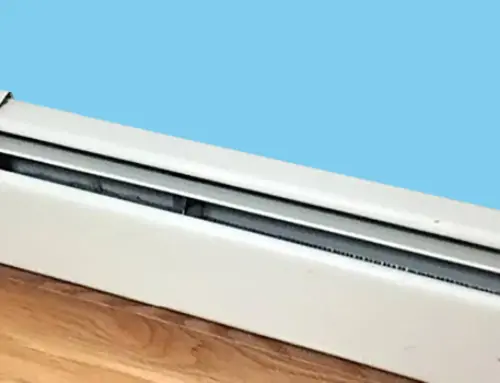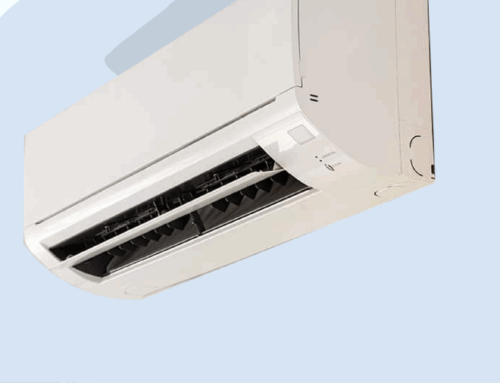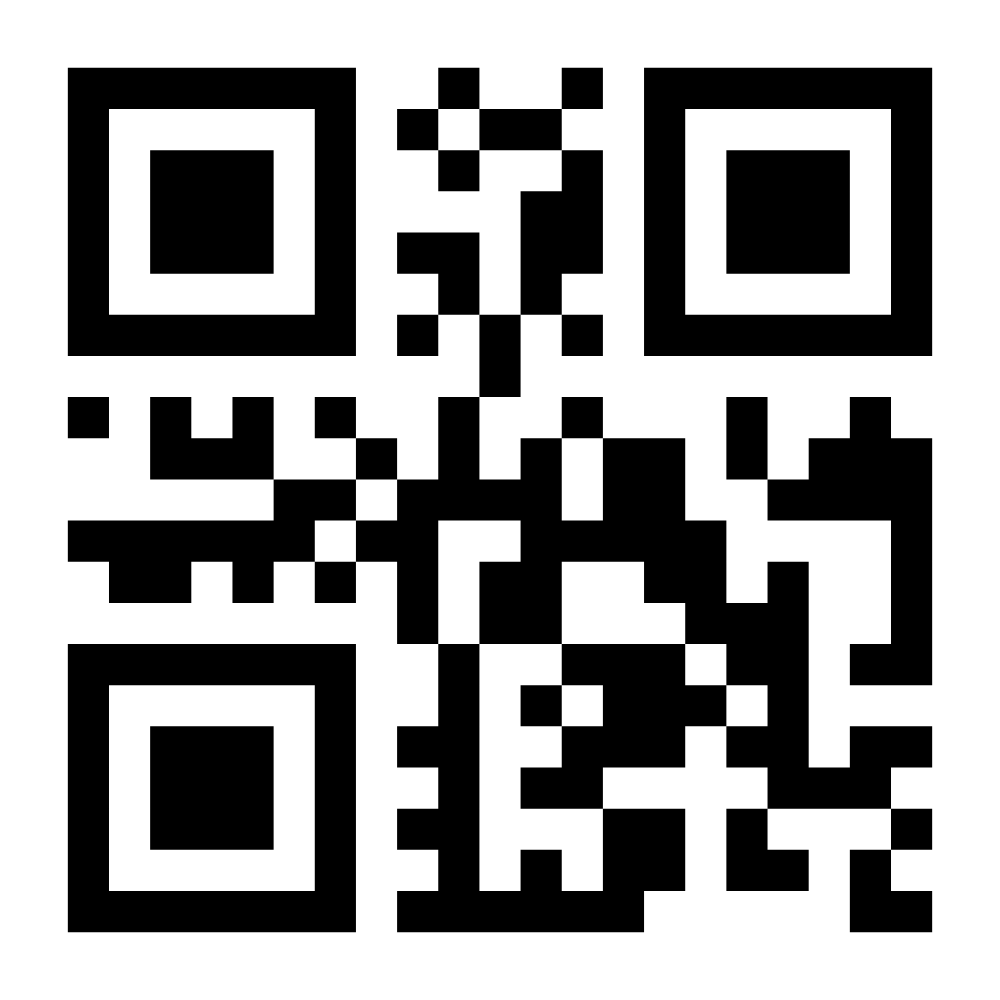Why Is My Heater Blowing Cold Air?
by Tyler Castle
19.2 min read
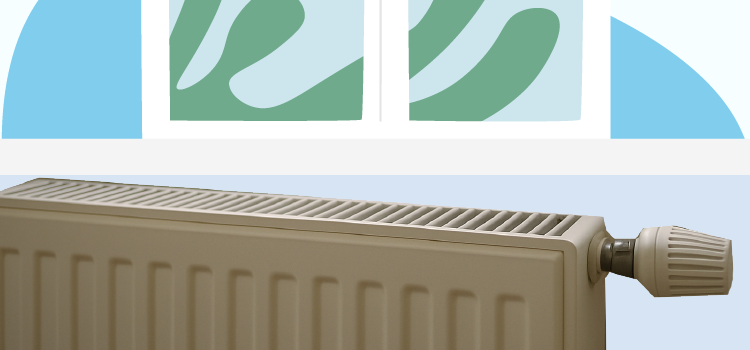
You expect your heater to be the hero of winter, keeping icy drafts at bay and your home warm and inviting. But instead of cozy heat, you're met with a blast of chilly air that makes you wonder, "Why is my heater blowing cold air?" This can feel frustrating, but it doesn't always mean your furnace is failing.
In many cases, the solution is simpler than you might think. With 35 years of experience in the electricity and natural gas business, we've seen it all. So, let us be your trusted source as we walk you through the most common causes, what you can safely troubleshoot on your own, and when it's time to call in a professional when your heater starts to blow cold air.
Along the way, we'll also look at how furnace hiccups can waste energy and raise bills, and how to keep both your home and budget protected through Midwest winters.
Key Points of This Article:
- A heater blowing cold air is often caused by thermostat mix-ups, dirty air filters, blocked ducts, ignition problems, or safety shut-offs.
- You can often fix simple issues by replacing filters, checking thermostat settings, relighting a pilot light, unblocking vents, or replacing thermostat batteries.
- Call a technician if the furnace experiences ignition failures, frequently shuts down due to overheating, emits gas or burning odors, has clogged condensate drains, or displays signs of a cracked heat exchanger.
- Malfunctioning furnaces and heat pumps can waste fuel or electricity, running nonstop without heating properly and significantly increasing winter utility bills.
How Your Home Heater Works
The job of your heater is to keep your home warm and comfortable when the weather outside isn’t, and it does this in two main ways: through either a furnace or a heat pump.
Furnaces make heat. They burn fuel like natural gas or use electricity to create warmth using a series of fans that blow that warm air through ducts and out your vents to warm your home.
Heat pumps, on the other hand, move heat. Even in cold air, there’s some heat energy, and heat pumps harness this energy by pulling heat from outside to bring it indoors and spread it throughout your home.
In both cases, the goal is to take cooler indoor air, heat it up, and push it back into your living spaces. When this process is interrupted, whether due to a clogged filter, a thermostat issue, or something more serious, your heater may continue to blow air, but it won’t feel warm. Let’s dive into some common causes.
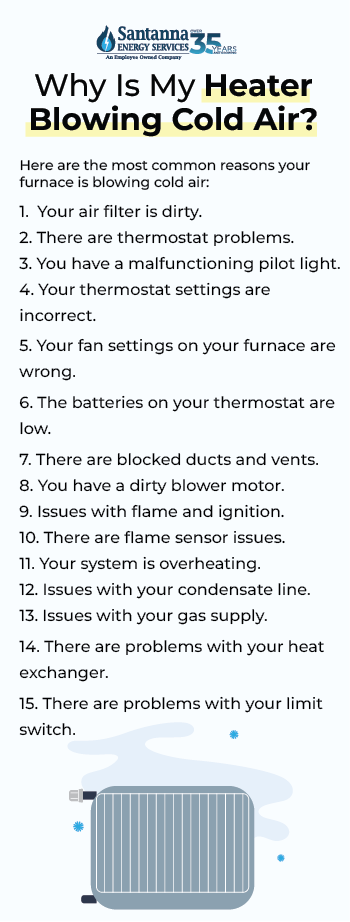
Why Is My Heater Blowing Cold Air? (If You Have a Furnace)
If your furnace is running but only blowing cold air, it likely means something in the heating process isn’t working right. Some issues can be fixed with simple troubleshooting, while others require the help of a professional. Either way, running a furnace or heat pump that isn’t heating wastes energy and drives up your bills.
Here are the most common causes of a furnace blowing cold air and what you can do about it:
1. You Have a Dirty Air Filter
One of the most common reasons why your heater is blowing cold air is a dirty air filter. A clogged filter restricts airflow, which can make the furnace overheat. When that happens, the system often shuts off the burners (cutting off gas flow to the system) as a safety precaution while the fan continues to run, pushing out cold air.
To solve this, simply remove the filter and hold it up to the light. If you can’t see through it, it’s time for a replacement. During the heating season, we recommend changing your filters every 1-3 months.
2. You Have Thermostat Problems
Sometimes, the issue isn’t with the furnace at all but with the thermostat. A faulty or miscalibrated thermostat may fail to signal the furnace correctly, causing it to run without producing heat.
Make sure your thermostat is set to HEAT and the temperature setting is higher than the current room temperature. If your furnace still won’t produce heat, the thermostat may need recalibration or even replacement.
3. There’s a Malfunctioning Pilot Light (Gas Furnaces)
For gas furnaces, a malfunctioning or extinguished pilot light can cause your heater to blow cold air. Without a steady flame, the burners cannot ignite, which means no heat.
Check the pilot light window to see if the flame is lit. If it’s out, follow the manufacturer’s instructions for relighting it. If it won’t stay lit, call a technician to inspect and repair it.
4. Your Thermostat Settings Are Incorrect
Another simple reason your furnace may blow cold air is incorrect thermostat settings. If the thermostat is accidentally set to COOL instead of HEAT, the system will run but only circulate cold air. Always double-check the settings.
5. The Fan Settings on Your Furnace Are Wrong
If the fan on your furnace is set to ON, it will run nonstop, even when the furnace burners aren’t producing heat. Switching the fan setting to AUTO ensures the blower only runs during actual heating cycles.
6. Your Thermostat Has Low Batteries
The furnace may blow air but not produce heat if the thermostat batteries are weak or dead, causing communication problems between the thermostat and the furnace. Replacing the batteries is a quick and easy fix that often restores proper heating.
7. There Are Blocked Ducts and Vents
Sometimes, the furnace is working, but warm air never makes it into your living spaces because the ducts or vents are blocked. Rugs, curtains, or furniture covering vents can trap air, and leaky ductwork can let heat escape before it reaches your rooms.
Unblock the vents and, if you suspect air leaks, consider having your ductwork inspected or sealed by a professional.
8. You Have a Dirty Blower Motor
Dust buildup makes it harder for the blower to move air. If left unchecked, the motor can overheat or burn out. Weak airflow or unusual noises are signs of blower problems, which should be cleaned or repaired by a technician.
9. There Are Flame or Ignition Issues
If the burners can’t ignite, the furnace won’t heat. This could be caused by a dirty igniter, a weak pilot, or a faulty flame sensor. While you can relight a pilot light, ignition problems typically require a professional to diagnose and fix safely.
10. There Are Flame Sensor Issues
A dirty or broken flame sensor may shut off the gas supply even if a flame is present. This is a safety feature, but it leaves the furnace blowing cold air. If your furnace cycles on and off while only producing cold air, a technician may need to clean or replace the flame sensor.
11. Your System is Overheating
An overheating furnace can cause the burners to shut down while the fan continues to run. This often happens when airflow is restricted, usually by a dirty air filter. If replacing the filter doesn’t solve the issue, call a technician to inspect the blower motor or safety switches.
12. There Are Condensate Line Issues (Mostly for High-Efficiency Furnaces)
High-efficiency furnaces generate water as part of their heating process, which drains away through a condensate line. If that line becomes clogged, a safety switch will shut down the burners to protect the system, leaving only the blower running. If you see water pooling around the furnace or suspect a clog, it’s time to call a professional.
13. There Are Issues with Your Gas Supply
If the gas valve is closed or the supply line is weak, the burners won’t ignite. Check that the gas valve is open. If gas is on and you still don’t have heat, contact your utility company or an HVAC professional immediately.
14. You Have Heat Exchanger Issues
A cracked exchanger can prevent the furnace from heating and poses a serious risk of carbon monoxide exposure. If you suspect a cracked heat exchanger (characterized by strange smells, soot, or a carbon monoxide alarm going off), shut down the furnace immediately and call a technician.
15. There Are Limit Switch Problems
The limit switch tells the furnace blower when to turn on and off. If it malfunctions, the fan may run at the wrong time and blow cold air instead of warm. Because limit switches are part of the safety system, they should be inspected and replaced by a qualified technician if they are faulty.
Common Causes of Your Heat Pump Blowing Cold Air
If you heat your home with a heat pump instead of a traditional furnace, you might notice it sometimes feels like it’s blowing cool or even cold air in the winter. This doesn’t always mean something is broken. Heat pumps operate differently from furnaces, and the air they produce isn’t usually as hot. Here are some of the common causes of a heat pump blowing cold air:
1. Normal Operation Can Feel Cooler
Heat pumps typically deliver air at around 80 to 115°F, while furnaces often push out air that is over 120°F. That temperature difference makes the air from a heat pump feel cooler on your skin, even though it is slowly warming your home. As long as your home is reaching the thermostat setting, this is completely normal.
2. Your System’s Defrost Cycle
Heat pumps aren’t ideal for homes in extremely cold weather since heat pumps tend to take a dive in functionality when temperatures dip below 32°F.
In cold weather, frost or ice can build up on the outdoor coils. To clear it, the system briefly switches into cooling mode, which may send cooler air into your home for a few minutes while the outdoor unit heats itself to melt the ice. This is normal unless the cycle runs too often or lasts more than 10–15 minutes.
3. There Are Thermostat Settings or Problems
Just like a furnace, a thermostat that’s set incorrectly, running on weak batteries, or suffering from faulty wiring may cause your heat pump to run in cooling mode instead of heating.
A miscalibrated thermostat can also cause the system to cycle incorrectly, leading to cold-air output. Always check the thermostat settings and replace batteries before assuming a larger issue.
4. Low Refrigerant Levels
Heat pumps rely on refrigerant to move heat from the outside air into your home. If the refrigerant is low due to a leak, the system cannot transfer enough heat indoors.
Warning signs include lukewarm air from vents, ice on the outdoor unit, or a sudden rise in energy bills. Refrigerant problems should only be handled by a licensed technician.
5. There Are Outdoor Unit Issues
For a heat pump to work properly, the outdoor unit needs clear airflow. Ice buildup, snow, leaves, or other debris can block the system and reduce heating performance. A failing fan motor or damaged coil can also weaken heating.
Keeping the unit clean and clear throughout the winter helps avoid these problems.
6. You Have a Dirty or Blocked Air Filter
Just like furnaces, heat pumps need strong airflow to operate efficiently. A clogged filter forces the system to work harder and may leave you with cold or weak airflow. Replacing filters every 1–3 months helps prevent this.
7. There’s Leaky or Uninsulated Ductwork
If your ductwork has holes, gaps, or poor insulation, warm air can escape before reaching your living spaces. This makes the air at your vents feel cooler than it should. Leaky ducts not only reduce comfort but also waste energy, which shows up in higher utility bills.
8. You Have a Faulty Reversing Valve
Heat pumps switch between heating and cooling using a component called the reversing valve. If this valve malfunctions, the system may get stuck in cooling mode, blowing cold air even when it should be heating.
A heat pump blowing cold air isn’t always a breakdown, but if your home never reaches the temperature you’ve set or your bills suddenly spike, it could mean wasted energy and a system that needs professional service.
Why Does My Furnace Blow Cold Air Even When the Heat Is On?
If your furnace is set to HEAT but only pushes out cold air, it usually means something is interrupting the heating process. Sometimes it’s normal for a furnace to blow cool air for the first minute while the burners warm up, but if it never gets hot, there’s a problem.
One of the most common reasons is the thermostat fan setting. If it’s set to ON instead of AUTO, the blower will run constantly, even when the burners aren’t producing heat. A dirty air filter can also be the culprit, since it blocks airflow, causes the furnace to overheat, and shuts off the burners as a safety measure.
For gas furnaces, problems with the pilot light or igniter can prevent the burners from lighting at all. A faulty flame sensor may also cut off the gas supply, and leaky ductwork can let warm air escape before it ever reaches your vents.
In some cases, mechanical components such as the limit switch or control board may be malfunctioning. If the problem isn’t resolved after simple checks, such as changing the filter or adjusting the thermostat, it’s best to call a professional to prevent wasted energy and maintain a comfortable home.
Is It Dangerous if My Heater Blows Cold Air?
Most of the time, a heater blowing cold air is not immediately dangerous. It mainly makes your home uncomfortable and wastes energy. Simple issues such as a thermostat set incorrectly, a clogged air filter, or a heat pump running through a normal cycle are not safety risks on their own.
There are, however, situations where cold air can point to a more serious problem:
- Gas furnace issues: If the pilot light or burner is not working, the system may continue to run without producing heat. While this may seem like just cold air, problems with ignition or combustion can sometimes be connected to gas leaks or carbon monoxide concerns.
- Overheating shutdowns: Furnaces have built-in safety switches that blow cool air if the unit overheats. This is a sign that something is wrong inside the system, and forcing it to continue running could cause long-term damage.
- Frozen pipe risk: In very cold Midwest winters, a heater that cannot keep up may let indoor temperatures fall low enough for water pipes to freeze and burst. This can cause costly water damage in addition to heating issues.
The air itself is not harmful, but the reason behind it is what matters. If the cause is a simple filter change or thermostat adjustment, you can usually resolve it quickly. If your furnace keeps blowing cold air after these basic checks, it is safer to call a licensed HVAC technician to protect both your home and your health.
When to Call a Furnace Technician for Cold Air Problems
Some furnace problems can be solved with a filter change or thermostat adjustment, but others involve gas lines, ignition systems, or electrical controls. These are not safe to handle on your own. A licensed technician can not only repair the immediate issue but also check for hidden problems that waste energy, shorten furnace life, or put your family at risk.
- Pilot Light Won’t Stay Lit or Igniter Won’t Fire: If your pilot light constantly goes out or the igniter fails to spark, it usually points to a gas supply issue, ignition failure, or a dirty flame sensor. These problems require professional tools and expertise to fix safely.
- Repeated Overheating Shutdowns: When your furnace overheats, safety switches turn off the burners, leaving only the fan running. If this continues to happen, a technician should inspect the limit switch, blower motor, or possibly a clogged heat exchanger.
- Strange Smells or Sounds: Burning odors, gas smells, or loud banging noises coming from your furnace can signal dangerous conditions. These symptoms should never be ignored and always require professional attention.
- Condensate Line Issues (High-Efficiency Models): High-efficiency furnaces create water as they run. If the condensate drain line is clogged, water can back up, shutting down your system and potentially causing water damage. A technician can clear the line and prevent future blockages.
- Electrical or Control Board Problems: If your circuit breaker keeps tripping or the furnace control board malfunctions, it’s a sign of electrical issues that should only be repaired by a professional. Attempting to fix these yourself can be unsafe.
- Suspected Cracked Heat Exchanger: A cracked heat exchanger is a serious hazard because it can leak carbon monoxide into your home. If you suspect this issue, shut off the furnace immediately and call a technician right away.
Some furnace problems are simple, but issues with gas lines, ignition systems, or electrical controls can be dangerous if handled incorrectly. A technician can repair the problem and check for hidden issues that waste energy, shorten furnace life, or put your family at risk.
How a Malfunctioning Heater Affects Energy Waste & Your Monthly Bills
A furnace or heat pump does not need to completely break down to drive up your energy costs. When it is running but not heating properly, every extra minute it runs is money slipping out of your pocket.
If the system runs all day but never reaches the set temperature, it is burning through gas or electricity with little to show for it. This, of course, can raise your bill and leave your home uncomfortable.
On top of this, dirty filters, clogged ducts, or weak blowers force the furnace to work harder. This uses more power and can also shorten the lifespan of the system.
Similarly, when burners fail to light, the blower continues to run on electricity. This wastes energy without producing any heat. Even worse, a furnace that overheats and shuts down repeatedly wastes gas and electricity each time it restarts.
According to the Department of Energy, heating and cooling make up 43% of a home’s monthly utility bill. So why spend more than you have to? A malfunctioning system does not just make you cold; it can quietly add tens or even hundreds of dollars to your utility bills until it is fixed.
How to Prevent Your Heater From Blowing Cold Air
The best way to avoid the frustration of a heater suddenly blowing cold air is to stay ahead of common problems. A furnace or heat pump does not usually fail overnight. Most issues build up slowly, and regular care can keep them from turning into expensive repairs.
Here’s how you can prevent your heater from blowing cold air:
Change Your Air Filter Regularly: A dirty filter is the most common reason furnaces blow cold air. Replacing it every 1–3 months during the heating season keeps airflow strong, prevents overheating shutdowns, and lowers your energy bills.
Schedule Annual Maintenance: A yearly tune-up by a licensed HVAC technician helps catch small issues before they turn into big ones. They’ll clean burners, check ignition systems, inspect electrical parts, and make sure your furnace or heat pump is running efficiently.
Keep Vents and Ducts Clear: Make sure vents aren’t blocked by rugs, curtains, or furniture. Leaky or damaged ducts let warm air escape before it reaches your rooms. Sealing and insulating ducts can improve efficiency and keep your home evenly heated.
Check Thermostat Settings: Double-check that your thermostat is set to HEAT and the fan is on AUTO. If you use a programmable or smart thermostat, set schedules so your system runs only when needed.
Inspect The Outdoor Unit (For Heat Pumps): If you have a heat pump, keep the outdoor unit clear of snow, ice, and debris. Blocked airflow makes it harder to transfer heat inside.
Address Small Problems Quickly: If you notice your furnace short-cycling, making unusual noises, or struggling to heat certain rooms, don’t ignore it. Fixing issues early prevents wasted energy and keeps your system reliable when you need it most.
FAQs
Is it worth repairing my old heater, or should I consider upgrading?
If your furnace is over 15 years old, needs frequent repairs, or has a major problem like a cracked heat exchanger, replacement is usually the smarter long-term choice.
How can I fix my furnace if the pilot light is damaged?
If the pilot light won’t stay lit or the assembly is damaged, it’s not something to fix yourself. A technician will clean or replace the thermocouple, ignition system, or pilot assembly safely.
Should I turn off my heater if it’s blowing cold air?
Yes. If your furnace runs but isn’t heating, you’re wasting energy and possibly causing more damage. Turn it off until you can troubleshoot basic issues (such as the filter or thermostat) or call a professional.
Can a thermostat cause the heater to blow cold?
Yes. Incorrect settings, low batteries, wiring issues, or a malfunctioning thermostat can prevent the furnace from heating.
How long can a house stay warm without a working furnace?
It depends on outdoor temperatures and insulation. In freezing weather, homes can drop below safe indoor temperatures (below 50°F) within 8–12 hours. Poorly insulated homes lose heat faster.
What’s the fastest way to warm up my home while I wait for repairs?
Use space heaters safely in occupied rooms, reverse ceiling fans to push warm air down, seal drafts with towels or weatherstripping, and close doors to unused rooms.
Is it normal for my heater to blow cold air at first?
Yes. Furnaces often blow room-temperature air for the first minute or two before burners fully heat up. It’s only a problem if it never switches to warm air.
How often should I schedule furnace maintenance?
At least once a year, ideally in the fall before heavy heating use. Annual tune-ups improve efficiency, prevent breakdowns, and extend equipment life.
A furnace or heat pump blowing cold air can be stressful, especially in the middle of a Midwest winter. Sometimes the fix is as simple as changing a filter or adjusting thermostat settings; other times, it takes a professional to resolve issues like ignition failures, ductwork leaks, or safety shut-offs. What matters most is catching the problem early so you don’t waste energy, strain your system, or drive up your bills.
And while you can’t always control when your heating system acts up, you can control your energy supply costs. With Santanna’s Unlimited Energy Plan, your supply charge stays the same no matter the season or how much energy you use.* That means peace of mind in the coldest winter or the hottest summer with predictable supply charges, year-round comfort, and one less thing to worry about when your home’s systems are working overtime. Explore Santanna’s Unlimited Energy Plan today and take the chill out of unpredictable bills.
* Restrictions apply. Enrollment based upon program eligibility. Customers using more than 125% of normal monthly usage as determined by Santanna may be required to switch plans.
Tyler is an experienced energy professional, having worked for Santanna Energy Services, for the past four years. He is passionate about renewable energy and believes that diversifying the energy grid is the key to a sustainable future. Tyler is dedicated to supplying consumers with the best possible energy solutions and works diligently to make sure that Santanna can deliver the highest quality service.




